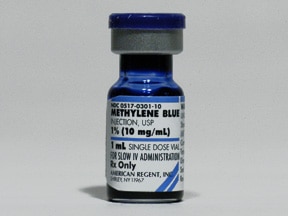Clinical Scenario:
You are working in Trauma Critical Care when a middle aged male with end-stage liver disease presents with altered mental status. He is hypotensive and tachycardic. You resuscitate him with IV fluids, start broad spectrum antibiotics and initiate vasopressors. You confirm a source of infection with a paracentesis. Despite multiple and escalating doses of pressors, the patient's blood pressure continues to fall. You perform a RUSH exam, run through your differential diagnosis again, and confirm that all lines and tubes are connected appropriately. As you prepare his family for the worst and sign him out to the ICU, your colleague suggests - what about methylene blue? Is it worth a shot?
You are working in Trauma Critical Care when a middle aged male with end-stage liver disease presents with altered mental status. He is hypotensive and tachycardic. You resuscitate him with IV fluids, start broad spectrum antibiotics and initiate vasopressors. You confirm a source of infection with a paracentesis. Despite multiple and escalating doses of pressors, the patient's blood pressure continues to fall. You perform a RUSH exam, run through your differential diagnosis again, and confirm that all lines and tubes are connected appropriately. As you prepare his family for the worst and sign him out to the ICU, your colleague suggests - what about methylene blue? Is it worth a shot?
Clinical Question:
Is there a role of methylene blue in management of septic shock?
Is there a role of methylene blue in management of septic shock?
 |
| Image source: webmd.com |
Literature Review:
Methylene blue was initially developed as a dye for the
textile industry, then used as a stain for TB, treatment for malaria, treatment
of cyanide toxicity, and more recently methemoglobinemia. Typical dosing for methemoglobinemia is
1-2mg/kg of 1% solution IV.
In a recent review performed by the Toxicology Department at
UCSD published in the Journal of Emergency Medicine in 2013, the authors
presented the evidence behind the utility of methylene blue in the septic
patient [1].
Methylene blue (MB) is useful in septic shock due to its
ability to increase peripheral vascular resistance and its reversal of
myocardial depression. Its mechanism of
action is thought to be due to inhibition
of inducible nitric oxide synthase (up regulated by endotoxin and cytokines
producing vasodilatory nitric oxide and guanylate cyclase (makes
vasodilatory cGMP) [2,3]. There have only
been two randomized controlled trials that studied MB in septic shock (n=20;
n=30). In these studies MB was found to
increased mean arterial pressure (MAP) and decrease vasopressor requirements,
but there was no statistically significant difference in survival rates.
Other studies reviewed for this publication were case series
and case reports. In these, varying
doses of MB were used ranging from 1-3mg/kg over 10-20 minutes, which all
increased MAP, systemic vascular resistance (SVR), and mean pulmonary arterial
pressure. However MAP and SVR returned
to baseline 2-4 hours after MB administrations.
With doses greater than 4mg/kg or rapid or prolonged (greater than 6-10 hrs)
infusion, potential side effects of MB use includes serotonin syndrome
reaction (if already taking serotoninergic agents, MB inhibits monoamine
oxidase), methemoglobinemia (if G6PD deficiency, or at high doses MB acts as
oxidizer instead of reducer), platelet aggregation/reduction, and
vasoconstrictive effects with possible
decreases in splanchnic perfusion and arterial oxygenation (do not use in ARDS
or pulmonary hypertension) [1,3,4]. The clinical effects of MB
persist for 2-3 hours (half-life=102 minutes) and should be preferably
administered centrally as peripheral administration can cause cutaneous
necrosis [3,4].
Take home points:
-Methylene blue may prove a useful adjunct to vasopressors
in cardiovascular collapse.
-Remember additional
shock management strategies include adequate volume resuscitation and source
control, inotropy, respiratory support, correction of electrolytes (K, Ca, Mg,
Phos) and glucose, consideration of endocrine dysfunction (thyroid, adrenal,
vasopressin), and ruling out obstructive etiologies.
References:
1. Lo JC, Darracq MA, Clark RF. A review of methylene blue
treatment for cardiovascular collapse. J Emerg Med. 2014 May;46(5):670-9.
2. Landry DW, Oliver JA. The pathogenesis of vasodilatory shock. N Engl J Med 2001; 345(8): 588-595.
2. Landry DW, Oliver JA. The pathogenesis of vasodilatory shock. N Engl J Med 2001; 345(8): 588-595.
3. Kirov MY, Evgenov OV, Evgenov NV, Egorina EM, Sovershaev MA, Sveinbjørnsson B, Nedashkovsky EV, Bjertnaes LJ. Infusion of methylene blue in human septic shock: a pilot, randomized, controlled study. Crit Care Med 2001; 29(10): 1860-1867.
4. Juffermans NP, Vervloet MG, Daemen-Gubbels CR, Binnekade JM, de Jong M, Groeneveld AB.. A dose-finding study of methylene blue to inhibit nitric oxide actions in the hemodynamics of human septic shock. Nitric Oxide 2010; 22(4): 275-280.
4. Juffermans NP, Vervloet MG, Daemen-Gubbels CR, Binnekade JM, de Jong M, Groeneveld AB.. A dose-finding study of methylene blue to inhibit nitric oxide actions in the hemodynamics of human septic shock. Nitric Oxide 2010; 22(4): 275-280.
Submitted by Lydia Luangruangrong, PGY-3.
Edited by
Faculty reviewed by Chris Holthaus
No comments:
Post a Comment